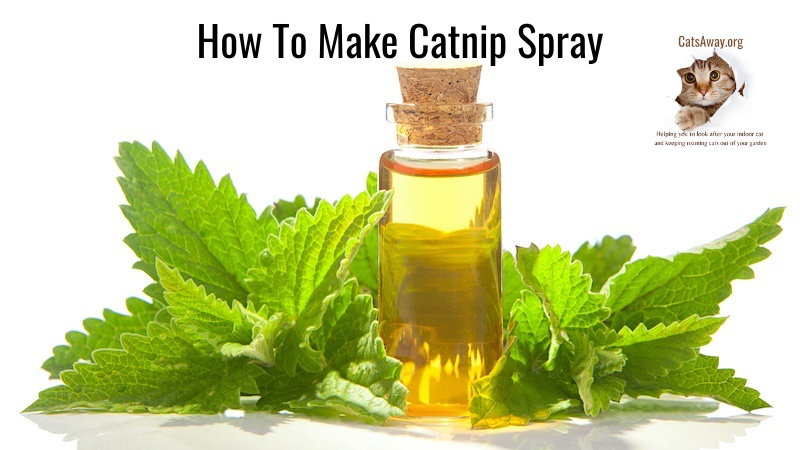Maintaining your cat’s dental health is essential for their overall well-being, and brushing their teeth can play a crucial role in this process. Dental plaque and tartar buildup can lead to various issues ranging from bad breath to severe oral infections. A simple yet effective routine can go a long way, so let’s dive into the world of cat dental care.
Learning how to brush cats teeth might seem challenging at first, but with the right guidance, patience, and tools, it can become a manageable and rewarding part of your pet’s grooming routine. In this article, you’ll discover how to brush cats teeth, ensuring that both you and your feline friend can navigate this task with ease.
Why Brush Your Cat’s Teeth
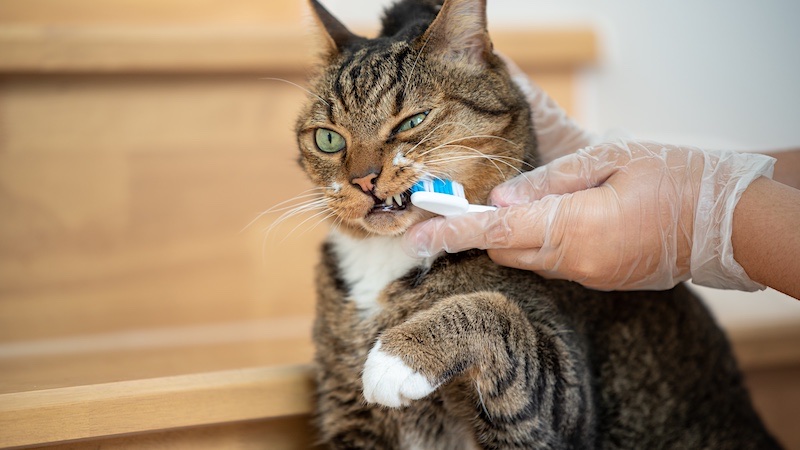
Knowing how to brush cats teeth is important for maintaining their overall dental health. A staggering 50-80% of all cats over the age of four suffer from periodontal disease, an infection of the tissues surrounding the teeth. This condition typically begins as gingivitis, caused by plaque coming into contact with the gums.
Addressing dental health early on can prevent inflammation and tooth decay, keeping your cat’s mouth in tip-top shape. Additionally, proper dental care can help fight bad breath, also known as halitosis. This makes cuddling sessions with your feline friend even more enjoyable.
Taking care of your cat’s teeth isn’t only about oral health; it can also prevent complications related to heart and kidney functions. A regular brushing routine, combined with veterinarian checkups, oral rinse, and professional teeth cleanings can ensure your cat stays healthy and happy.
Remember to avoid using human toothpaste, as it may contain xylitol and fluoride, ingredients harmful to cats. Instead, opt for cat toothpaste, which is specifically formulated for feline dental hygiene.
When to Begin Teeth Brushing
Introducing teeth brushing to your cat can start at any age, but it’s best to begin when they’re still a kitten. This helps establish good dental hygiene habits early on and allows them to become more comfortable with the process.
During the first few sessions, focus on making your cat feel at ease. Choose a time when they’re calm and the house is quiet. Gently handle their mouth and muzzle area for a few seconds, praising them afterward. This should be repeated regularly until your cat becomes accustomed to the handling.
Daily or twice-daily brushing is ideal for preventing dental disease. However, if your cat is older and has never had their teeth brushed before, don’t worry – it’s possible to introduce them to this routine with patience and appropriate care.
Be prepared that some cats may still develop dental issues despite regular brushing, but maintaining a consistent routine is still beneficial for their overall oral health.
Choosing the Right Toothbrush
Quick and Easy – HIBOS Chika-pen is a combination of toothbrush and toothpaste. If you don't want to put toothpaste on your toothbrush and just click on the back a few times like a ballpoint pen, toothpaste comes out of your toothbrush.
Selecting the correct toothbrush for your cat can make the process much smoother. A finger toothbrush is a popular choice, as it allows for easier control and a gentle touch. Alternatively, a human baby toothbrush with soft bristles can also be used, as it is gentle on your cat’s gums.
Some cat owners have even had success with a simple finger brush or even using a small amount of coconut oil on their finger as a makeshift toothbrush and paste.
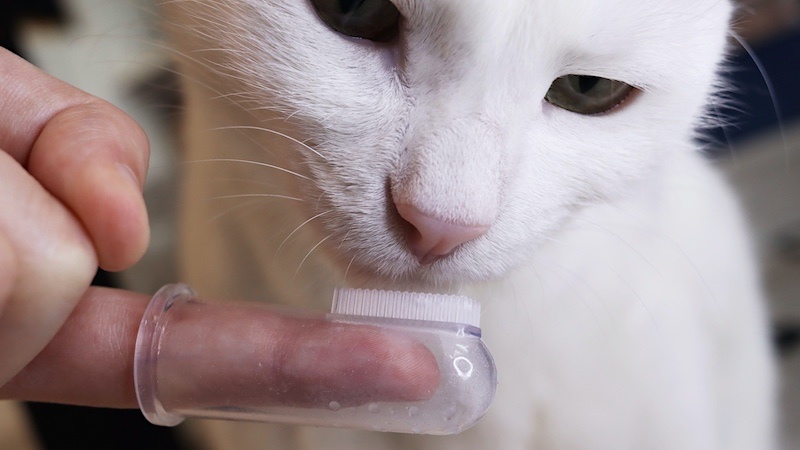
Remember to replace your cat’s toothbrush regularly to maintain its effectiveness and use a separate toothbrush for each cat in your household to avoid cross-infection. With the right toothpaste and toothbrush in hand, you’re well on your way to maintaining your cat’s oral health.
Brushing Your Cat’s Teeth Step by Step Instructions
Before starting, ensure you have a cat-friendly toothbrush and recommended pet toothpaste. Human toothpaste can be harmful to cats, so stick to the specially flavored pet toothpaste.
Begin by letting your cat lick a small amount of toothpaste off your finger. This helps them get used to the taste. Once they’re comfortable, place some toothpaste on the toothbrush for them to lick, as this will acclimate them to the brush.
When your cat is ready, gently hold their head at a 45-degree angle and pull back their lips. The mouth can remain closed. Carefully rub the toothbrush along the gum line, where plaque accumulates and may cause gingivitis. Focus on the outside surfaces of the teeth as they’re most affected by bacteria.
Establishing a daily routine is key to maintaining good dental health in cats. Consistent brushing will help prevent plaque, tartar buildup, and keep their gums healthy. Remember, it might take some time for your cat to adapt to this practice, so be patient and use positive reinforcement.
Periodic professional cleanings can also aid in maintaining overall dental health. Keep an eye on your cat’s teeth and gums for signs of irritation or other issues requiring veterinary attention.
Training Your Cat for Teeth Brushing
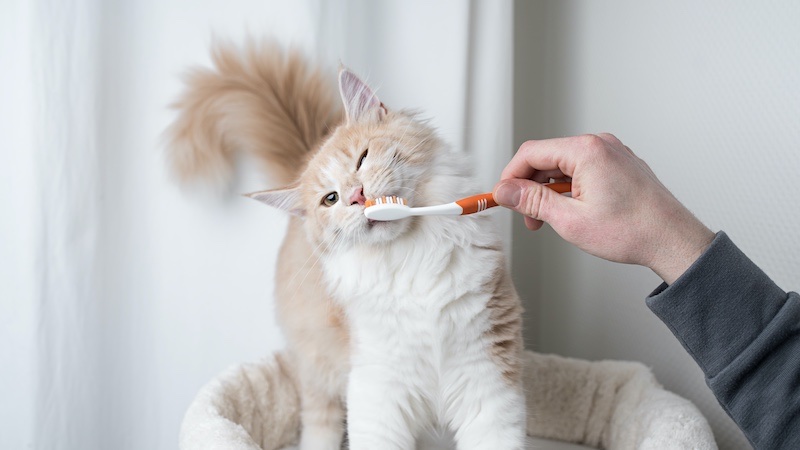
Training your cat to accept tooth brushing can be a gradual process, but is key to preventing dental issues. First, acclimate your cat to having their mouth touched. Gently lift their lips and massage the gums for a few seconds, then reward with praise or treats.
Gradually increase the amount of time you spend touching their mouth, ensuring they remain comfortable. If your cat shows signs of anxiety, such as trying to squirm away or hissing, take a break and try again later. Patience is crucial to make this a positive experience.
Before moving on to actual brushing, introduce your cat to the toothbrush and paste. Choose products specifically designed for cats, as human toothpaste can cause irritation. Let them sniff and lick the toothbrush and paste to familiarize them with the items.
When your cat is comfortable with having their mouth and gums touched, and is familiar with the toothbrush and paste, start gently brushing along the gum line. Focus on the outside surfaces of the teeth, since this is where plaque typically accumulates.
Remember to keep the training sessions short and always end on a positive note with praise or treats. Consistent practice will help your cat adjust to this routine, and eventually, it should become a smooth, stress-free process for both of you.
Professional Dental Cleanings and Other Preventative Measures
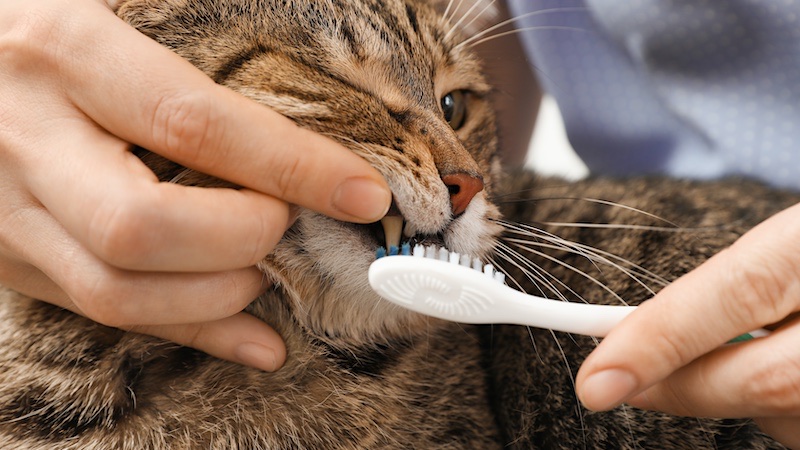
Taking your cat to a veterinarian for regular professional dental cleanings is an important part of maintaining their oral health. During these visits, the vet will perform a thorough cleaning to remove plaque and tartar buildup that cannot be addressed through at-home care.
Cats will need to be under anesthesia for a proper dental cleaning. This ensures that they remain calm and allows the veterinarian to thoroughly examine their mouth and clean all areas, including those that are difficult to reach. It also allows for dental x-rays to be taken when necessary, providing a clear picture of your cat’s oral health.
Veterinary dental cleanings typically include a comprehensive oral examination, removal of dental plaque and tartar, polishing the teeth, and applying a fluoride treatment. This process helps prevent periodontal disease and other dental issues that can impact your cat’s overall health.
In addition to professional dental cleanings, it’s essential to establish good oral care habits at home. Brushing your cat’s teeth regularly with a cat-friendly toothbrush and toothpaste, as well as providing dental treats and toys, can help maintain their oral hygiene between visits to the vet.
By ensuring your cat receives both professional dental cleanings and proper at-home care, you can greatly reduce the risk of dental issues and keep their mouth healthy for years to come.
Toothbrush Alternatives
6 month supply - Two finger brushes + cases included for 6-12 months brushing.
US COMPANY - Jasper is a US brand proudly owned and operated in America. Don’t accept foreign knockoffs.
Cats can be quite finicky when it comes to getting their teeth brushed, so it’s essential to know some alternative options. Cat dental chews, for instance, can serve as a tasty and effective choice for maintaining your cat’s oral health. They usually contain enzymes that help break down plaque and tartar.
Another option is using a finger brush to gently rub your cat’s teeth and gums. This might be more comfortable for some feline friends. You can also try water additives, which simply mix into your cat’s drinking water to help reduce plaque buildup.
For daytime dental care, dental chews can be a useful aid. These chews typically have a textured surface that helps in removing plaque while your cat enjoys their treat. Additionally, some oral hygiene products contain baking soda, which acts as a mild abrasive to clean teeth surfaces.
Oral rinses, such as Virbac’s CET Oral Hygiene Rinse, can be applied directly to your cat’s mouth, helping to freshen breath and reduce plaque accumulation. Moreover, supplements can be added to your cat’s diet to support overall oral health, like those that promote collagen production for strong gums.
Overall, it’s imperative to avoid forcing your cat into an uncomfortable tooth brushing situation. Offering alternatives ensures their oral health remains a priority while keeping stress levels at a minimum.
Common Dental Issues and Signs
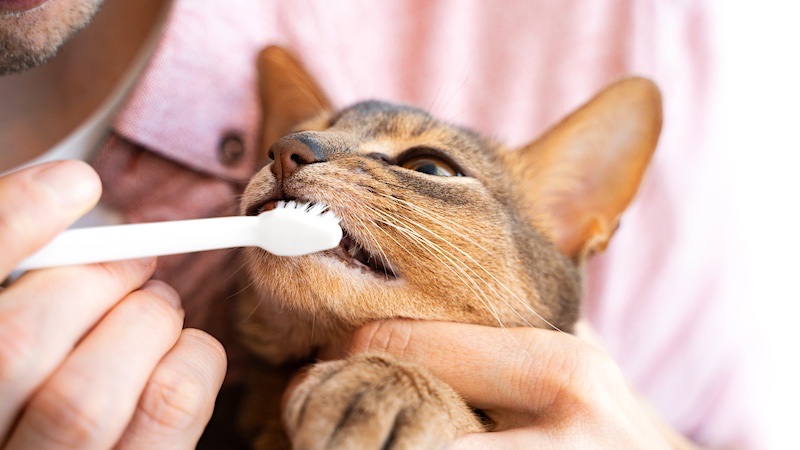
Cats can experience a variety of dental issues that often lead to discomfort and health problems. One common problem is gum disease, which can result in infection, bone loss, and tooth loss if left untreated. Another issue is tooth resorption, a painful condition where the cat’s own body begins to break down and absorb its tooth structure.
Cats with dental problems often exhibit signs such as difficulty chewing, pawing at their mouth, head shaking, and jaw chattering. It might be noticeable when a cat chews with discomfort, dropping food or swallowing with difficulty. Excessive drooling, sometimes containing blood, is another indicator of dental issues. Additionally, bad breath, or halitosis, is a common symptom of many oral diseases or systemic illnesses like diabetes and kidney disease.
Regularly brushing your cat’s teeth can help prevent and manage these dental issues. It not only reduces plaque and tartar buildup but also promotes healthy gums, reducing bad breath. In case of persistent signs, visiting a veterinarian for proper diagnosis and treatment is essential for maintaining your cat’s long-term oral health.
The Role of Diet in Dental Health
A well-balanced diet plays a significant role in maintaining your cat’s dental health. Feeding your feline friend with commercial diets explicitly designed to retard plaque and calculus accumulation can help, especially if you cannot brush their teeth regularly. These preventive diets work by altering the cat’s saliva properties, making it more challenging for plaque to stick to their teeth.
Dry kibble can also be beneficial for your cat’s dental hygiene. Its abrasive texture helps remove plaque as the cat chews, reducing the risk of dental disease. However, it is essential to remember that just feeding dry food is not a substitute for daily toothbrushing. Only a combination of proper diet, toothbrushing, and dental check-ups can ensure long-term oral health for your cat.
Remember that treats and wet food can also contribute to dental issues if not consumed in moderation. Many treats contain sugars that can cause plaque buildup, while wet food often sticks to the teeth, promoting bacteria growth. It is vital to monitor your cat’s treat intake and consider dental-friendly alternatives such as dental chews to maintain a healthy mouth.
In conclusion, a proper diet can work wonders for a cat’s dental health. By providing them with nutrition designed to delay plaque formation, using treats wisely, and combining it with regular toothbrushing sessions, your cat’s dental hygiene will be in tip-top shape.
Conclusion
Caring for your cat’s teeth through daily brushing can make a world of difference in preventing dental issues. By taking just a few minutes each day, you’ll be able to minimize tartar buildup and reduce the risk of infections that could potentially spread through the bloodstream and cause harm to other organs.
Home care is an essential part of maintaining your feline friend’s oral health. Brushing your cat’s teeth with a small-headed toothbrush or dry Q-tip, along with pet-safe toothpaste, helps promote healthy gums and keeps those pearly whites shining. Remember, never use human toothpaste, as it may contain harmful ingredients for cats.
It’s wise to consult with your veterinarian and follow guidelines recommended by the Veterinary Oral Health Council to ensure the best possible dental care. With proper attention to your cat’s teeth and gums, you’ll be supporting overall well-being and can contribute to a happier and healthier life for your beloved pet.







